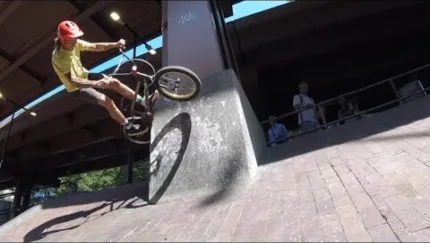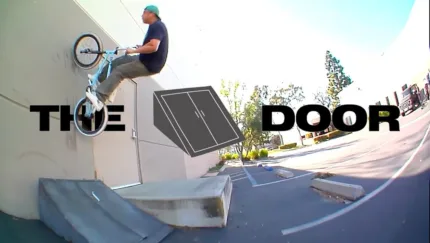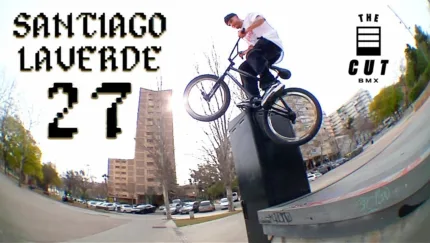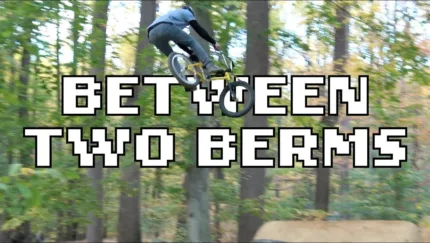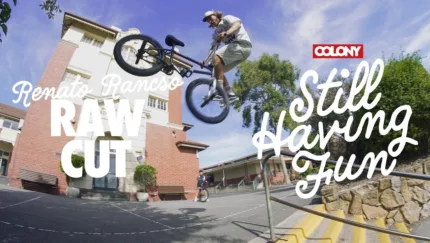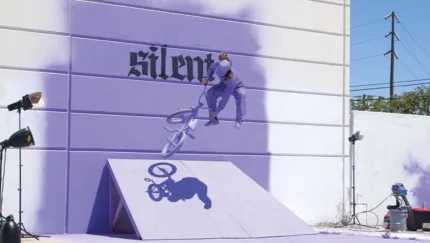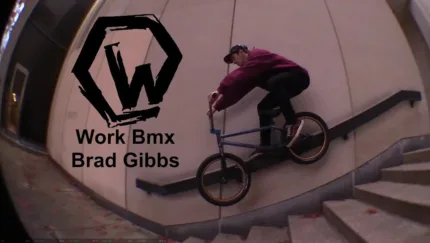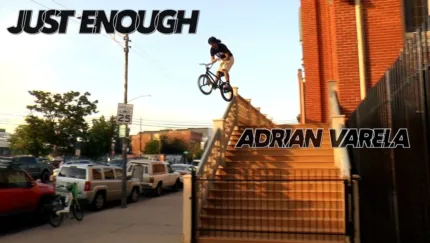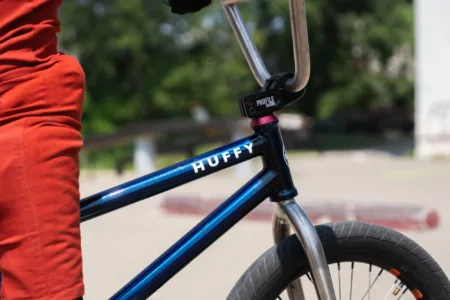
Mat Hoffman - The Dangers Of Flying On A Budget
"Ramps are not dangerous unto themselves. Confidence. Now that can be dangerous" - Mat Hoffman
9 Jan 2015

The bike that really started the birth of Big Air and the infamous weedeater in the background. Mat Hoffman at home - Fall 2008
Portrait by Andrew White Words and photos courtesy of Mat Hoffman / Originally published in DIG issue 66 September 2008
Ramps are not dangerous unto themselves. Confidence. Now that can be dangerous.In 1994, I pulled a 23-foot aerial out of a 21-foot tall quarterpipe. It was the highest air ever done on a bicycle, and one of the most fantastic feelings I’d ever experienced riding vert. In 1997 I started on another massive air crusade. The plan involved building myself a 26-foot tall ramp for my 26th birthday. I wanted to break the 30-foot air threshold, and, the “26/26” thing had a good ring to it. I knew it was possible to top 30 given the right ramp and the proper speed. However, fate intervened before I could put my theory to the test, and a string of injuries smashed my birthday wishes. Instead of raging airs, I found myself fighting battles to keep my knees and shoulders operational. Riding was taken away from me by the weakness of the human body. Every time I blew out my ligaments, I had to start over, relearning and recuperating, promising myself not to push too hard. but I never forgot about the prospect of clearing 30. The thought lay dormant in my head, and as my body got better, I wondered if the day would come when I’d find myself looking down a runway at a wooden monster.

“I can’t help it—this is the way I am, it’s who I am, and what I have to do.” So, despite their best efforts to dissuade me, my family and friends gave in. I was beyond help"
In 2001, I had the indoor park adjacent to the Hoffman bikes warehouse updated with some new terrain. The featured attraction was a half with 11-foot tall transitions, capped with nearly two feet of vert. I could roll in from a platform 12-feet above the deck (25-feet off the ground) and b-o-o-m, a 15-foot aerial on the first wall without breaking a sweat. It was the perfect place to play, and of course, I got injured very quickly. I knocked myself out pretty good on one occasion, and wasted my knee on another. I’d been on a self-destructive cycle for almost five years when I finally realized I didn’t have to rush to make a return to the contest scene. I could just relax, re-learn, and re-experience vert as pure recreation. Instead of working myself up, trying to get my riding back to competition level, I tried a different comeback tactic. Every time I dropped in, I treated each run as if it were my last. I let myself heal, and gradually put together lines, throwing down tricks and having fun. Every foot of air I moved up the height pole was like unwrapping a gift. Soon I was feeling strong and consistently floating 15-foot airs again. And that was when I steered down the path of no return: The desire for big airs was re-ignited. The more I thought about it, and what a cool stamp it would be on my career…30-feet!…the more I wanted it.
When I lock into an idea that stokes me, I enter a state of mind I can only describe as consumed—I’m basically along for the ride and at the mercy of whatever project is on the table. That drive, combined with a love for looking down past my right shoulder and seeing the coping way below me, is what led me back into big transition territory.

This was 1991 right after Steve and I fi nished building the soon to be dubbed 'mega super duper crazy ramp', but at the time it was just called 'the big ramp'.
RAISING THE STAKES
The first obstacle I faced was my family and friends. I’d always been blessed to have an inner circle of people who believed in me through good times and bad, contributing to my success in million different ways. Everybody should be as lucky as I am to be surrounded by such great people. but, I started bringing up the term giant ramp, and ran into a wall of resistance from everybody on this one. my wife Jaci didn’t want me to do it. Steve [Swope] didn’t want me to do it. Nobody wanted me even thinking about riding another big ramp. I’d always justified the unacceptable aspects of my lifestyle by calling my conviction an addiction: “I can’t help it—this is the way I am, it’s who I am, and what I have to do.” So, despite their best efforts to dissuade me, my family and friends gave in. I was beyond help.
I knew exactly what they were afraid of—the same thing I was. I’d lost a spleen on previous high air attempts. The force of impact from a 50-foot crash could leave me broken beyond repair, or worse. but rather than be intimidated by the odds, I let the possible consequences dictate just how serious I needed to approach my goal. I didn’t want any excuses, and if I did get, as the saying goes, majorly fu*ked, I never wanted to look back and say, “I should have built a better ramp.” I called Tim Payne, a vertical engineer of serious reputation,
and laid out the plan. Tim and his crew of Dave Ellis and Mike Cruze—Team Pain—arrived in Oklahoma city within a couple weeks, bringing the power tools of the trade and sizable shopping list of materials. No more screwing around, nursing the project along for weeks and months, or standing on scaffolding in the middle of an ice storm trying to finish. I wanted this ramp to be flawless. Perfection came with a $30 thousand dollar price tag. The crew tore into the job like piranha, and my ramp went up in four days. When it was done,
the structure stood 24-feet tall—22-feet of transition with two feet of vert. Tim shook his head, shook my hand, and wished me luck. I cut him a check and he was gone.
The final factor in the formula was momentum. I needed speed to get high: 45, 50 miles an hour at least. Early experiences with Steve’s YZ 125 revealed his cycle wasn’t cutting it. To get rolling that fast meant a motorcycle purchase, a big 250 with the get up and go to tow my 165 pound body and 35 pound bike. $4,500 later, that situation was under control and we had a Yamaha YZ dirt bike. Steve, my tow pilot, needed convincing that I would not kill myself. I bartered with him, promising that if he towed me, just this one last time, I’d start wearing the seat belt in my car (a dangerous habit not to, I know…but…I just never could do it). Steve was aware that if he refused, I’d just get Page [Hussey] or one of the other guys to tow me. I was radiating confidence that I could pull it off, and so Steve reluctantly agreed.
The ramp was stationed on some unused acreage on my dad’s property. There was a 400-foot long plywood runway leading up the face. We made giant mat Hoffman Pro bmx stickers, stuck them at the edges of the ramp, and painted a huge Hoffman bikes skull logo in the center. These were my air traffic control beacons; when I started breaking the 20-foot range, the crisp details of the ramp and coping disappeared. At the peak of my airs, I had to aim for the paint, which lined me up about eight inches away from the coping. That comfort zone gave me plenty of transition to land on but also ensured I didn’t hang up if the wind pushed me back toward the deck. Landing too low, or hanging up from a height of 20something feet over coping would have catastrophic results.
There was a mix of tension, concentration, and glee as I started warming up. The ramp was solid as a mountain, and the runway was reasonably smooth, with the exception of a small bump where water drainage had formed a contour in the ground. I had my approach timing worked around the topography, and knew when to ready my body by the way the earth felt as it sped by underneath my wheels. When I passed a certain tree, I’d throw the knotted nylon tow rope, being careful not to run it over. Then I’d hit the tranny and go straight up. Instead of airs, it felt like I was doing kick-turns or fufanus in the sky. There was very little arc, just an incredible rush of momentum shooting me off the coping, and a few seconds later I’d reach my peak and gravity would stall out. Then I’d have to figure out how to turn around and get down from almost five stories up.

This photo I got the first day I was trying to figure out how to get speed. A random motorcycle guy pulled over and asked what the fuck I was doing. I said "trying to fi gure out how to hit this ramp fast" - then I asked him if he’d give me a tow on his street bike. He obliged. This if my fi rst day riding this ramp getting towed and clearing my old height pole. The next week, I won the “BMX Plus! Freestyler of the year” award, along with a motorcycle that I traded in for one that could tow me up to speeds that would clear 20+ feet.
I felt it right away. The first day I was hitting the 25-27 foot range, higher than I’d ever gone before. There were a couple of airs that were absolutely beautiful, the perfect merger of flesh, steel, air and wood. I could taste victory, and I knew it was only matter of time. All I had to do was solve the puzzle of the perfect pump up the transition, and a 30-foot air would be mine. There were a few kinks to work out, like the speedometer on the motorcycle. It was registering a steady 50 mph on approach, but sometimes it felt as slow as 48, other runs it might have been up around 60. It was one of those things I had to adjust to on the fly, using only my instincts.
The confidence I felt was blinding me to the dangers at hand, however. Riding big ramps required me to convert all my natural sense of caution into a sort of hyperawareness. I was so focused on what I had to do that I ignored the warning signs: a couple of sketchy landings where my arms almost gave out, another where I slid out on the way down the tranny and was sent skipping across the ground, leaving divots in the turf. I bounced up and threw both arms up—to signal that I was okay—but it was close. I could feel everybody around me tighten up. There was another air that I missed my timing so bad I just shot straight up, stalled and began falling in sideways—I dropped a good six feet drifting in that position before I was able to coax my front end and point it into the ramp, using body English to finesse myself around. Old school riders may
remember a ramp trick called the Jammin’ Salmon—you used your bike like a fin and “swam” through the air. That’s what I had to do to save that one. I played it back on the video camera and the height was almost there though. Another couple feet and I’d top the pole. I could feel the 30-footer in me, just waiting for everything to click…
FADE TO BLACK
The second I left the coping I could tell I wasn’t going to ride away from it. That was the worst part, being powerless to alter the situation as I shot straight up past the 20, 22, 25 foot hash marks on the pole. 50-feet and change above the ground. At that height, it’s pretty insane to toss your bike and
try to run out of it, so I held on, boned and came in crooked. I braced myself to take the hit, and landed way too hard. My arm, weakened after four rotator cuff surgeries, gave out and I nailed the ramp with a mighty spank. I don’t know if it’s a good thing, or a very bad thing, that I still don’t remember much of that day. The impact erased those memories - and all my memories - from my hard drive.
Later, I could barely bring myself to watch the crash on video. It was bad. This is what happened: My helmets are made by Simpson, and are bar none, the best head protection you can get. They’re the choice of pro stuntmen and NASCAR drivers, and cost $450 and up. Mine was even custom made, the ultimate armor with enhanced peripheral vision. When I hit, even the best helmet in the world could only do so much to save my head. I connected with the ramp and my face shield exploded, and the jagged fragments tore my lip off. I was instantly knocked out, and as I plowed across the ground my body was dead limp. It took my friends and family about three minutes to revive me.
There were a lot of tears that day. An ambulance arrived and rushed me to the hospital, where I spent the day in and out of consciousness, then another three days in a total fog, blacking out at random. Plastic surgeons got to work and put my face back together. A battery of branscans and EEGs revealed more terrible news—my brain activity was all over the place, abnormal. My memory was wiped, and I was so dizzy I didn’t regain my equilibrium for nearly three weeks. The doctors said there was nothing they could do except treat the symptoms, and prescribed a huge bottle of pills that I was supposed take every day for the rest of my life. The medication was definitely not an improvement; they doped me up to the point where all my senses were blunted. Riding was not an option.

This was ten years later. My original motivation was the idea that if I was clearing 10 feet on 10-foot ramps, then I should be able to clear 20 feet on a 20-foot ramp. In 2001, I built that roll-in on my indoor ramp and I was able to clear 15 feet on a 12-foot ramp. And then my mind started spinning, thinking it was time to push 30 feet on a 24-foot ramp. This shot was taken shortly before I ate shit, tore my lip off and lost my memory for eight months. Yes, it was worth it!
In all my years on a bike, I’d learned to diagnose injuries and had developed an internal sense of what was necessary to recover. But a head injury like this was impossible for me to assess—I’d damaged my brain, and was unable to use the very tools I needed to gauge the extent of how badly I was hurt. I kept forgetting things, and had no memories of vast chunks of my life. Jaci would mention something—like a trip we’d taken to Japan. “I’ve been to Japan?” I’d ask, stunned. She’d have to fill me in on the trip, or show me photos, and something would trigger a vague memory, and I’d be able to mentally re-assemble my experiences. As the weeks passed, my physical scars and injuries began to gradually heal. But, there was a lot of emotional damage too.
The people around me were worried for me, but they were also kind of pissed. I’d come damn close to taking myself out—twice. While everybody wanted to see me break my old height record, they wanted it because they hoped it would put an end to my obsession with huge airs. I don’t have a death wish, I have a life wish. I always craved the experience of living at my potential—that was the driving force behind every crazy thing I’d ever done. The 24-foot quarterpipe was part of that need, and for a long time I thought I’d never be able to top the feeling I got from 50-feet up. I was wrong.
One afternoon during my recovery, I was goofing around with our little girl, Gianna. She was only about four months old— since the day she was born she’d been basically a cooing, crying, gurgling little squishy thing wrapped in fuzzy clothes. But her senses were developing bit by bit, and that afternoon a change happened inside her, right in front of me. I made a face, and a silly noise. Gianna looked back at me with a sparkle in her eyes, and for the first time ever I made her laugh. I did it again, and her reaction doubled—she cracked up, hysterically. This funnyface game was repeated about 500 times. It was so awesome. Her laughter, and the look she gave me was the most precious substance. I think I changed during that moment, too. While my family and friends always had to accept me for who I was—a guy prone to high risk activities— my daughter had never agreed to those terms. I brought her into this world, and I had a responsibility to be there for her. That feeling I got from her laugher was a high that overpowered even my love for pushing my own limits. It put a knot in my stomach to think I could’ve missed out on her first laugh. As I lay there with my nose pressed to Gianna’s, everything clicked. It was time to leave the big ramps alone, and be satisfied with what I had: 26.5 feet, and a little person who could always count on me.
“You win.” I said to Gianna.
“Bloo,” she replied. – Mat Hoffman
"The impact erased those memories - and all my memories - from my hard drive"
This text is an un-edited extract from the book MAT HOFFMAN - THE RIDE OF MY LIFE
Previous
Re Print: The Bruno Hoffmann Interview - Too Much Too Young
If you go your own way, you cannot be overtaken.
Next
Low Profile - Shawn Real
A re-introduction of sorts for "one hell of a fucking ripper"...
Related Content










